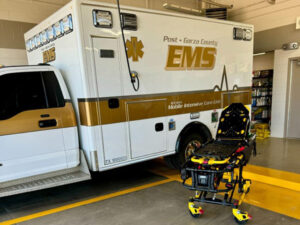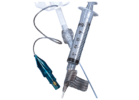Post-Garza County (TX) EMS Is First in State with Advanced Weighing Technology on Ambulance Stretchers
Post-Garza County EMS has become the first emergency medical service (EMS) in the state to deploy groundbreaking stretcher-mounted scales, revolutionizing the way patient care is administered in the prehospital environment.
“A critical component of EMS response is medication administration, particularly drugs where dosages must be calculated based on the patient’s weight,” said Post-Garza County EMS Administrator Rodney Tidwell. “This is where our initial interest in the solution sparked. Medications like ketamine, etomidate, and paralytics carry high stakes – too much or too little can mean the difference in patient outcome.”

Photo/Hinckley Medical
Funded by a generous grant from the Garza County Endowment Fund, this transformative technology was developed by Hinckley Medical. Known as the OneWeight Patient Scale, this equipment is integrated beneath the stretcher mattresses in their ambulances, ensuring minimal intrusion while maximizing functionality.
This system allows EMS personnel to accurately measure a patient’s weight in real-time, facilitating the precise administration of medications during critical moments of care. “Before integrating this into our operations, we were often left to make educated guesses about patient weights. This approach, as resourceful as it may have been, was fraught with risks,” explained Tidwell. “Since some of our EMS medications are specific weight-based administrations, this can add stress to the already chaotic environment of an ambulance.”
The weight data captured by OneWeight is transmitted to the OneDose Protocol Workflow Platform, enabling immediate and accurate medication dosing through an app without the need for manual calculations. “This advancement significantly reduces the potential for dosing errors, a critical improvement in patient safety and care. I remember a day with four high acuity calls back-to-back, where these tools allowed us to quickly reference the correct doses of etomidate, versed, and fentanyl,” added Tidwell.
The precision offered by this technology is particularly crucial when treating pediatric patients, where dosing errors can have severe consequences. Current studies, including those published in the Prehospital Emergency Care Journal, indicate that as many as one-third of pediatric medication doses administered prehospital may be critically incorrect.1
“This investment is another step forward in our commitment to excellence in patient care,” Tidwell noted, “proving that even in the most rural settings, advanced medical care is not just a hope, it’s a reality.”
As the first EMS team in Texas to utilize this innovative technology, Post-Garza County EMS sets a precedent for others in the region. With hospitals having utilized similar technologies for years, the extension of this capability to ambulances represents a significant advancement in prehospital medical care. For Post-Garza County EMS, the future is bright, and it’s precisely measured in pounds and kilograms.
Reference
1. John D. Hoyle Jr., Alan T. Davis, Kevin K. Putman, Jeff A. Trytko & William D. Fales (2012) Medication Dosing Errors in Pediatric Patients Treated by Emergency Medical Services, Prehospital Emergency Care, 16:1, 59-66.
















